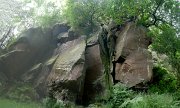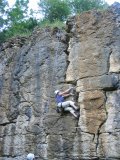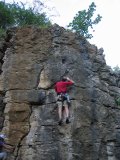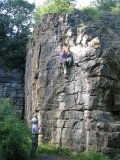 It was looking for a while like there'd be hardly anyone on this meet, perhaps people were put off by the thought of Langdale crowds on an August Bank Holiday weekend. But after a flurry of late sign-ups it was almost a sell-out.
It was looking for a while like there'd be hardly anyone on this meet, perhaps people were put off by the thought of Langdale crowds on an August Bank Holiday weekend. But after a flurry of late sign-ups it was almost a sell-out.
Saturday's forecast was for sunshine, and it didn't disappoint.
For many years I've meant to walk round the Eskdale skyline, but it's somehow never happened. So Carmen and I decided to take advantage of the weather and run an extended version of the route, starting and finishing at the hut. I say "run", but it was actually almost all walking! From part way up Wrynose, we headed up Pike o' Blisco, then across Crinkle Crags (there's definitely an extra crinkle every time I do this!) and Bowfell, over Esk Pike, and on to Scafell Pike.
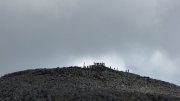 Despite being a sunny August BH weekend, there were surprisingly few people around, and we were wondering where they all were. As we approached the summit of Scafell Pike we got the answer, the place was heaving!
Despite being a sunny August BH weekend, there were surprisingly few people around, and we were wondering where they all were. As we approached the summit of Scafell Pike we got the answer, the place was heaving!
From here we descended under Scafell Crag, pausing to admire a hardy team of climbers on a very  cold-looking Moss Gill Grooves. As we scrambled up Lords Rake and the West Wall Traverse we were on our own again. Then over Scafell summit, down the south ridge over Slight Side, before descending into upper Eskdale, across the Great Moss and over the col into Mosedale. We briefly considered dropping down to Cockley Beck and finishing over Wetherlam, but rejected this as we needed to get back to cook dinner before Annie starved to death! So we traversed to the Three Shires Stone, over Wet Side Edge, and down the valley back to the hut, where we were surprised to be first back!
cold-looking Moss Gill Grooves. As we scrambled up Lords Rake and the West Wall Traverse we were on our own again. Then over Scafell summit, down the south ridge over Slight Side, before descending into upper Eskdale, across the Great Moss and over the col into Mosedale. We briefly considered dropping down to Cockley Beck and finishing over Wetherlam, but rejected this as we needed to get back to cook dinner before Annie starved to death! So we traversed to the Three Shires Stone, over Wet Side Edge, and down the valley back to the hut, where we were surprised to be first back!
Our route here for anyone interested.
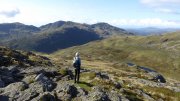 Meanwhile, Alan did his own long run, starting up Wethlam, Swirl How and Great Carrs, before a descent to Three Shires Stone. From here, another big ascent over Cold Pike to Crinkle Cragsand a descent of The Band led to a pint or two in the Old Dungeon Ghyll and a return via Blea Tarn.
Meanwhile, Alan did his own long run, starting up Wethlam, Swirl How and Great Carrs, before a descent to Three Shires Stone. From here, another big ascent over Cold Pike to Crinkle Cragsand a descent of The Band led to a pint or two in the Old Dungeon Ghyll and a return via Blea Tarn.
Steve, Rob, Luke and Mark spent the day climbing on Raven Crag, above the ODG. After a number of excellent severes, Rob and Steve climbed the route Rob had come for, Pluto (HVS ***). 3 Great pitches, a classic crack, an out there traverse and a lovely wall pitch, followed by a pint in the pub while waiting for Luke and Mark to find their way back down after an interesting choice of descent from their last route.
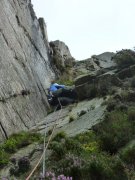 On Sunday, we headed for White Ghyll, with Rob, Steve, Mark and Luke. Always keen to try the obscure, I'd been looking for something from the Lake District Revival list. This crag provided the perfect route for me – Inferno (MVS), involving some back-and-footing at the crux. The first pitch looked a bit scrappy but the in situ heather didn't affect the climbing, which was better (and harder) than it looked. The long 2nd pitch provides the meat of the route, with steep parallel cracks leading to a niche in the overhang and the promised chimney practice. Pausing to clean the grass out of the cracks and place loads of gear, everything turned out to be a lot less traumatic than expected, with just a brief moment as the final pull onto the upper wall required unearthing some holds from behind the heather.
On Sunday, we headed for White Ghyll, with Rob, Steve, Mark and Luke. Always keen to try the obscure, I'd been looking for something from the Lake District Revival list. This crag provided the perfect route for me – Inferno (MVS), involving some back-and-footing at the crux. The first pitch looked a bit scrappy but the in situ heather didn't affect the climbing, which was better (and harder) than it looked. The long 2nd pitch provides the meat of the route, with steep parallel cracks leading to a niche in the overhang and the promised chimney practice. Pausing to clean the grass out of the cracks and place loads of gear, everything turned out to be a lot less traumatic than expected, with just a brief moment as the final pull onto the upper wall required unearthing some holds from behind the heather.
The rest of the route was a bit scrappy, but we topped out anyway. For future reference, an enticing diagonal line rightwards from above the crux looked a better option, and I later discovered is recommended in the new guidebook. Despite the vegetation, it's a really good route, full of character, and with a bit more traffic would once again deserve the 2 stars it used to get.
 Having humoured me by climbing a route from the choss list, Carmen now got her reward as we did White Ghyll Wall (VS 4c). I led the easy first pitch, Carmen led the crux second, I did the not so hard but quite bold final pitch. We finished the day with a repeat ascent of Slab Route 1 (Severe). A fine route, rather bold in places, Steve and Luke also climbed this earlier in the day.
Having humoured me by climbing a route from the choss list, Carmen now got her reward as we did White Ghyll Wall (VS 4c). I led the easy first pitch, Carmen led the crux second, I did the not so hard but quite bold final pitch. We finished the day with a repeat ascent of Slab Route 1 (Severe). A fine route, rather bold in places, Steve and Luke also climbed this earlier in the day.
Rob and Mark started with the excellent Slip Knot (VS 4b) before heading for Haste Knot (VS 4c). A nice first pitch despatched by Mark with ease then the meat of the route, the traverse. Rob's verdict – "Blimey, if you think Pluto is nuts this is bat shit crazy. Well protected with small wires but wild."
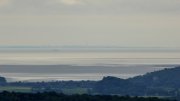 Monday was cold and grey, so we joined Peter, Annie and Steve for a short walk round, round, round, and finally up and over Whitbarrow. Highlight of the day was finding loads of wild damsons! Afterwards we popped into Ambleside to pick up our rewards for doing a route from the choss list – a free T shirt and chalk bag each!
Monday was cold and grey, so we joined Peter, Annie and Steve for a short walk round, round, round, and finally up and over Whitbarrow. Highlight of the day was finding loads of wild damsons! Afterwards we popped into Ambleside to pick up our rewards for doing a route from the choss list – a free T shirt and chalk bag each!
Rob, Mark and Luke manage to fit some more climbing in, doing a couple of good short routes at a different Raven Crag, this one at Walthwaite, before rain stopped play.
More photos here



